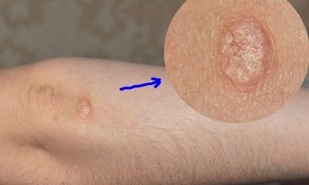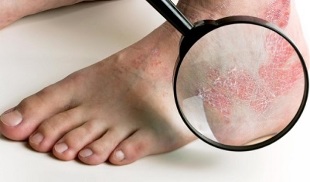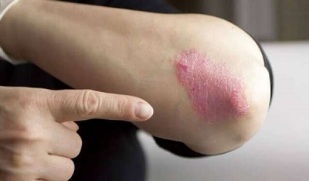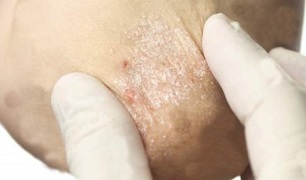Psoriasis is an inflamed skin disease. Occurs when the immune system is not functioning. The development of the disease is divided into clear stages - appearance, development, stabilization and regression. Different levels of psoriasis differ in the appearance of spots and rashes, painful itching and extensive skin inflammation.
Why is it necessary to differentiate between the stages of development of the disease, and what are the characteristics of the course of psoriasis at the beginning of development and in the process of recovery?
Why you need to know the stages of psoriasis

The division of psoriasis becomes the level used by doctors for the choice of the right method of therapy. The complex of drugs and external agents prescribed to treat inflammation depends on the stage of disease progression.
At the beginning of the manifestation of the disease, general therapy is required - vitamin complexes, diet, external aseptic treatment of the rash, for example, UV procedures. Also prescribed drugs that stimulate the cleansing of the intestines, blood vessels, liver.
Be sure to correct your psychoemotional condition - by a neurologist or psychologist.
In the early stages of the disease, they do not use strong drugs that can kill the immune system, do not give hormonal ointments. This medicine has a large list of side effects, so this medicine is only prescribed when it is impossible to do without the medicine.
Psoriasis: treatment in the acute stage and in remission
If there is an acute progressive disease, several multi-action drugs are prescribed. Immunosuppressants and glucocorticosteroids are often used to relieve inflammation and reduce itching. External treatment is complemented by photochemical, ultrasound and laser therapy. Also, agents are prescribed for antiseptic treatment on damaged skin.
In stable condition, they continue to take anti-inflammatory hormone medication, gradually reducing the dose. To restore damaged skin, an ointment with a regenerating effect is prescribed.
In forgiveness - supports the body. Proper nutrition, take vitamin and mineral complexes to restore immunity.
Punctuality of treatment
The earlier treatment is started, the easier it is to handle psoriasis.

Timely therapy limits the spread of skin inflammation, reduces its levels, and prevents recurrence. Since psoriasis is often mistaken for an allergic rash at an early stage, it is necessary to know the early signs so as not to miss the appearance of skin diseases.
Note:doctors are still investigating the cause of psoriasis. But it is well known that psoriatic inflammation of the skin is not contagious. It should not be taken from a sick person, or an infection in the event of an injury. This is our own personal failure in the human body.
The cause of psoriasis is immune failure, which can be caused by a variety of factors. Severe stress, poisoning (including strong drugs, industrial waste, alcohol), previous infections.
Psoriasis is difficult to treat. The disease is recurrent, recurrent. And the therapy itself is symptomatic. This consists of preventing the appearance of new spots and eliminating existing itchy skin.
What is the stage of psoriasis called early? How to distinguish early psoriasis from diathesis rash? And how will this disease develop in the future?
Psoriasis: early stages
The first appearance of psoriasis on the skin looks like acne. Often, the rash appears at the elbows and knees, or in places where clothing is pressed tightly to the body (for example, under the belt at the waist). The rash can also appear along the edges of the hair and under the hair, around the nails and on the nail plate. Sometimes psoriasis occurs on the feet and palms.
Almost always, psoriasis manifests itself symmetrically - on the elbows of both hands, or on both sides of the lower back, or on both knees.
Acne itself (in medical terms - papules) at an early stage has a mild appearance. They have:
- Pink or red;
- Sharp and blurred edges;
- Small size - acne at the base does not exceed two millimeters;
- Flat shape - small pimples at the beginning of the disease are barely noticeable, so they look like spots.
As the disease progresses, flaky skin fragments appear on acne. They are gray or silvery, with a background of red pimples they look white.
The appearance of scales is accompanied by a slight itching. If you do not push and scratch, the scales will be removed, displaying a shiny pink skin area underneath. It is very thin, susceptible, by scratching prolonged itchy papules - wounds, bleeding.
The early stages of psoriasis last up to four weeks.
Psoriasis: developmental stage

At the progressive stage, individual acne merges into one common place, forming a so-called psoriatic plaque. They are raised on the surface of the skin and completely covered with exfoliation. On the edges of the psoriatic plaque there are pink-red rims that do not peel off.
The presence of a rim is a sign of a progressive stage of the disease. Rims one to two millimeters wide. The skin on it is inflamed and resembles parchment paper in structure.
Rim represents the area of expansion of the place. This is skin that is already inflamed, but has not peeled off. After a while, it will also be covered with scales. And the patch will expand to cover new areas of skin and form wider rims.
With the active development of the disease, adjacent places merge with each other. At some point, a large, inflamed red dot can form on the human body.
Psoriatic plaques are very itchy, give a person an unpleasant sensation, interfere with work, rest and sleep. They grow, take up large areas, and form new rashes on clean, healthy skin.
The main sign of a progressive stage is the appearance of a new rash. Once acne and new spots stop appearing, the next stage of psoriasis begins - not moving. This is not a complete victory, but it is already a recovery.
In the developmental stage, psoriasis is almost always accompanied by weakness, fatigue, weakness. Depression is common. Temperature is possible.
Note:some medical theories say otherwise. Depression is not the result of psoriasis. And psoriasis is the result of neurological, depressed souls.
The duration of the progressive stage of psoriasis can be long, several months.
Psoriasis: stationary stage

The main sign of a stationary level is the cessation of the appearance of new spots and rashes. At the same time, the itching is also reduced, making it easier to bear. The rash loses bright color, becomes discolored, becomes invisible. This is also one of the signs that the process is stable.
The pink stripes around the perimeter of the plaque disappear as the inflammation stops spreading. Active exfoliation and healing begins, new healthy skin regrowth.
It is visible to the naked eye that exfoliation increases at a stationary level. The scales completely cover the entire surface of the psoriatic spot, leaving no room for rims.
Psoriasis takes on the sciatic features commonly known to the general public. Extensive exfoliation at stationary levels is harmless.
When all the dead cells come out of the surface of the psoriatic spot, healthy skin with a little light will stay in place.
Other signs of development or stabilization
In addition to the appearance of rashes, spots and scaling, there are a number of other signs that can be used to assess the progression of the disease. These are the properties of itchy sensations (strong or can withstand), general condition, depressed mood. And also the presence of temperature.
In the early stages, itching can change, and the rash is incomprehensible. Furthermore, the itching is increasing every day. In the acute stage of psoriasis, it becomes intolerable. Disrupts sleep, rest, interferes with work. The person becomes irritable because the itchy sensation does not give him a chance to rest.
At the stationary level, the itching subsides. Every day - someone feels better. The general state of the soul changes, negative and the mood of depression weakens. The duration of the stationary level is a few weeks - from 2 to 5.
Psoriasis at a debilitating stage

The fading level of psoriasis is the disappearance of plaques, spots, redness, inflammation, almost complete itching.
At this stage of the disease, psoriasis is only reminiscent of different skin pigmentations. On the site of the former psoriatic spot, it looks lighter. A healthy skin surface has a darker color.
In some cases, so-called hyperpigmentation is formed. The skin on the psoriasis spots does not become brighter, but darker. However, skin pigmentation differences can be seen for another to two months.
Psoriasis after healing: possible recurrence
The likelihood of recurrence of psoriasis is determined by lifestyle, diet, allergic mood, and the overall condition of a person's body. It is also determined by the amount of toxins in the body, blood, liver. You can reduce the likelihood of recurrent skin inflammation if you strengthen the immune system and cleanse the body of toxins in the liver, blood vessels, and intestines.
Seasonal psoriasis recurrence is usually rare after cleansing. A person remains prone to disease, but the chances of its occurrence are reduced.
Cleansing toxins in the body and taking vitamin and mineral complexes helps boost immunity. This is especially important if immunosuppressants are used during treatment, at the progressive stage of psoriasis. Their needs are due to the work of inflammatory mediators. After suppressing the autoimmune defense, it is necessary to restore the immune system.























